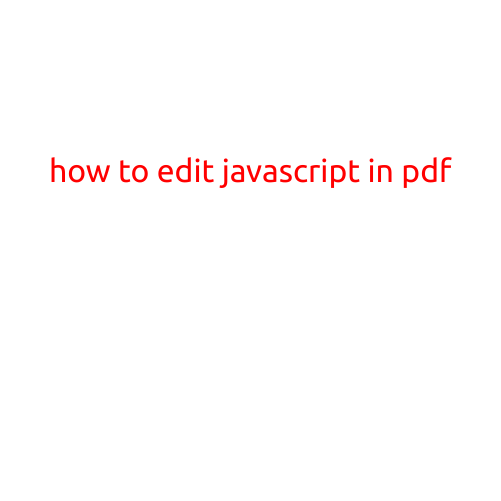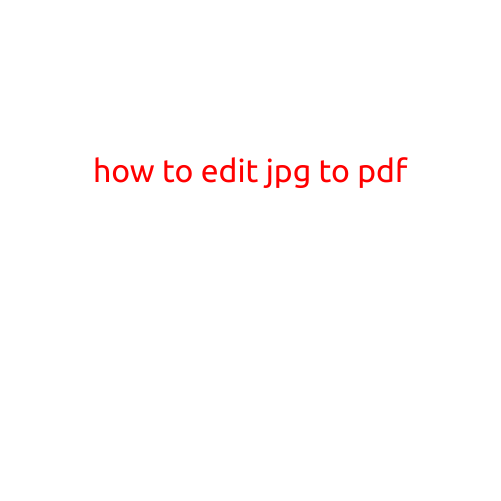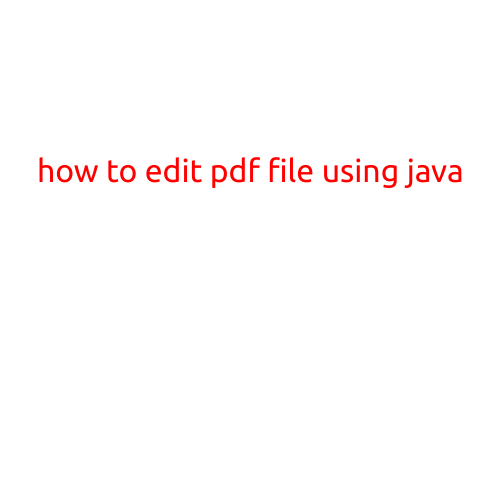
How to Edit JavaScript in PDF
PDF files are widely used for sharing and viewing documents, but they can be frustrating to work with when you need to make changes to the code. JavaScript, in particular, can be a challenge to edit in PDF files. In this article, we’ll explore how to edit JavaScript in PDF files and provide some tips and tools to help you do so efficiently.
Why Edit JavaScript in PDF?
Before we dive into the process of editing JavaScript in PDF, let’s understand why you might need to do so. There are a few reasons why you might need to edit JavaScript in PDF:
- Fixing errors: Sometimes, errors can creep into your JavaScript code when you export it to a PDF file. Editing the code directly in the PDF can help you identify and fix these errors.
- Updating functionality: If you need to update the functionality of your PDF file, such as adding or modifying interactive elements, you’ll need to edit the JavaScript code.
- Customizing the file: If you want to customize the appearance or behavior of your PDF file, you may need to edit the JavaScript code to achieve the desired results.
Tools for Editing JavaScript in PDF
Editing JavaScript in PDF files can be a challenging task, but there are several tools that can make the process easier. Here are some of the most popular tools for editing JavaScript in PDF:
- Adobe Acrobat: Adobe Acrobat is a powerful tool for editing PDF files, including JavaScript code. You can use it to open and edit PDF files, as well as to add new JavaScript code or modify existing code.
- PDF-XChange Editor: PDF-XChange Editor is a free tool that allows you to edit PDF files, including JavaScript code. It’s a great alternative to Adobe Acrobat and offers many of the same features.
- Nitro Pro: Nitro Pro is a popular PDF editor that includes a JavaScript editor for editing code directly in the PDF file.
- PDFelement: PDFelement is a powerful PDF editor that includes a JavaScript editor for editing code directly in the PDF file.
Steps for Editing JavaScript in PDF
Once you have chosen a tool for editing your JavaScript in PDF, you can follow these steps to edit the code:
- Open the PDF file: Open the PDF file in the tool you have chosen. If you are using Adobe Acrobat, you can open the PDF file by clicking on the “File” menu and selecting “Open.”
- Find the JavaScript code: Locate the JavaScript code in the PDF file. This may be in a separate file or embedded in the PDF file.
- Modify the code: Edit the JavaScript code as needed. Be careful when editing JavaScript code, as small mistakes can cause errors in the code.
- Save the changes: Save your changes to the JavaScript code. Make sure to save the changes in the correct location, such as in the same folder as the PDF file.
Tips and Tricks for Editing JavaScript in PDF
Here are some tips and tricks to keep in mind when editing JavaScript in PDF:
- Use a syntax highlighting editor: A syntax highlighting editor can make it easier to read and edit the JavaScript code. Adobe Acrobat and PDF-XChange Editor both offer syntax highlighting.
- Save frequently: Save your changes frequently to avoid losing your work.
- Use the “Find” and “Replace” functions: The “Find” and “Replace” functions can be useful for finding and replacing specific code or text in the PDF file.
- Use the “debug” function: Many PDF editors have a “debug” function that allows you to test and debug your JavaScript code.
Conclusion
Editing JavaScript in PDF files can be a challenging task, but with the right tools and techniques, it’s possible to make the process easier and more efficient. By following the steps outlined above and using the tips and tricks provided, you can edit JavaScript in PDF files with confidence. Remember to always save your changes frequently and to test your code to ensure it’s working correctly.





